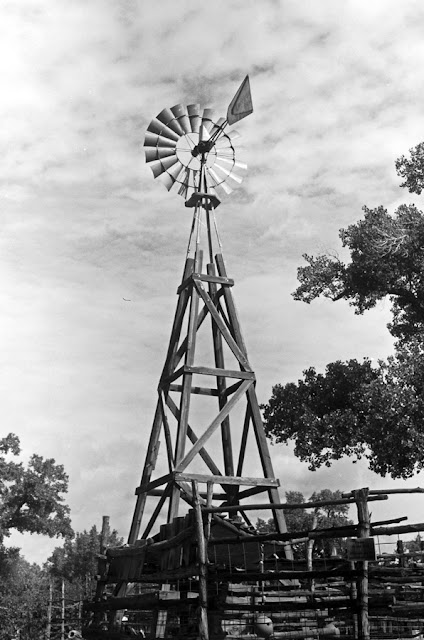The small size and light weight of the Vivitar Ultra Wide & Slim (vuws) camera makes it easy to carry. It often rides along in my shirt pocket, even when I am out mainly to shoot with another of my cameras. The result is that the roll of film in the vuws often ends up with a grab-bag of photos and several story lines. My last roll of film, some expired Fuji color, included walks through the neighborhood and a couple trips to the Rio Grande.
Our near-downtown neighborhood has undergone a lot of changes since we moved here about thirteen years ago, mostly in the direction of gentrification. Quite a few old working-class homes have been torn down and replaced with upscale two-storied block houses. The same fate has befallen local commercial buildings, though a few are being renovated and repurposed like this one at 6th St. and Mountain Ave.

The old door and windows are mostly sealed, to what purpose I don't know at present. The interesting thing I noted, however, is that stripping off an outer layer revealed an old painted identity, Farmer Brothers Coffee. My first thought was that the building had housed a long-gone coffee shop. Consulting google maps, however, I saw what looks like the new home of Farmer Brothers Coffee across town, and the description of the site as an importer, manufacturer and wholesale/retail seller of coffee, tea and other food items. I might have figured that out without google if I had not been buying just one brand of coffee for the last two decades. So, anyway, I went to the company's website and found a very nicely produced five-minute video history made to celebrate the company's one hundredth anniversary.

Meanwhile, much of the rest of the roll of film was taken up with my frequent visits to the Rio Grande and its bordering cottonwood forest, known locally as The Bosque. This time of year the main attraction for us is the marvelous blooming of the Yerba Mansa which covers acres of the riverside forest south of the Hispanic Cultural Center. The shaded setting is a bit of a challenge for the fixed-aperture camera, but the wide exposure latitude of the color film keeps picture harvesting a viable possibility.
For our dog, Roxy, the flowers hold little interest. For her, splashing in the shallows of the river is her greatest joy in life.

New Mexicans optimistically refer to their rainy season as The Monsoon. That has been a bit of a stretch with a historic average yearly rainfall of around ten inches. Now, even those ten inches are getting hard to come by and the state is in a long term period of drought. In fact, the possibility has been raised that the river at Albuquerque could run dry this year; something I believe that no one now alive has seen. Of course, there are no hard and fast rules when it comes to weather. The reality is that the amplitude of the extremes has heightened with climate change. Two years ago the Rio Grande, swollen with some sudden rains and snowpack runoff, overflowed its banks and turned bosque paths into swift moving streams. This year those floods are a dim memory as sandbars crowd the river channel. We'll find some water for Roxy to indulge her passion, but it may not be in the Rio Grande.




























